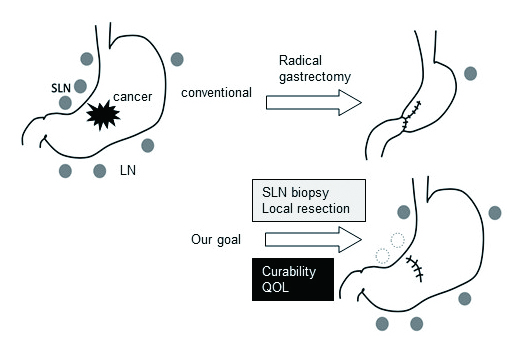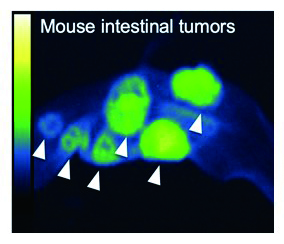Minimally-invasive next-generation gastric cancer surgery using molecular-targeted fluorescent tilmanocept
Project Gist
Establishment of next generation gastric cancer center to achieve both curability and functional preservation with minimally invasive surgery
Keywords
gastric cancer, curability, minimally invasive, functional preservation
Background and Purpose
The aim of this project is to establish minimally invasive gastric cancer surgery that can achieve both curability and functional preservation. National Cancer Center reported that mortality of gastric cancer is the second in 2014 among all cancers in Japanese population, and morbidity is the third in 2017. Endoscopic resection is the standard treatment procedure for early gastric cancer that is small, withing mucosa and without lymph node metastasis. On the other hand, radical gastrectomy (distal gastrectomy, proximal gastrectomy or total gastrectomy) with lymphadenectomy is the standard for advanced gastric cancer without distant metastasis (The 4th edition of Japanese gastric cancer treatment guideline). However, stomach is an important endocrine organ that controls nutrition absorbance in addition to food digestion. After radical gastrectomy, some patients showed weight loss or anemia, resulting in becoming decreased quality of life.
Project Achievements
Our project emphasized the importance of international collaboration. Therefore, we, Kyoto University, cooperated with University of Yamanashi, University of California, and Columbia University. We started the project to detect gastric cancer localization and lymphatic flow with fluorescent detector. Later on, we expanded the adaptation of the disease to esophagus and colorectal cancers. We tried to establish the procedure of the radical surgery with appropriate lymphadenectomy using fluorescent lymphatic flow navigation.
Future Prospects
We try to keep establishing minimally-invasive personalized robot-assisted surgery using fluorescent navigation reagent, and verify its safety and efficacy. In addition, we will pursue translational researches that can directly associate with minimally-invasive robotic surgery.
Figure


Principal Investigator

ITATANI Yoshiro
Department of Surgery, Kyoto University Hospital
His specialty is minimally-invasive colorectal surgery. He calls himself as a Surgeon Scientist, combining basic research with clinical research to achieve translational research.
http://gisurg.kuhp.kyoto-u.ac.jp/
